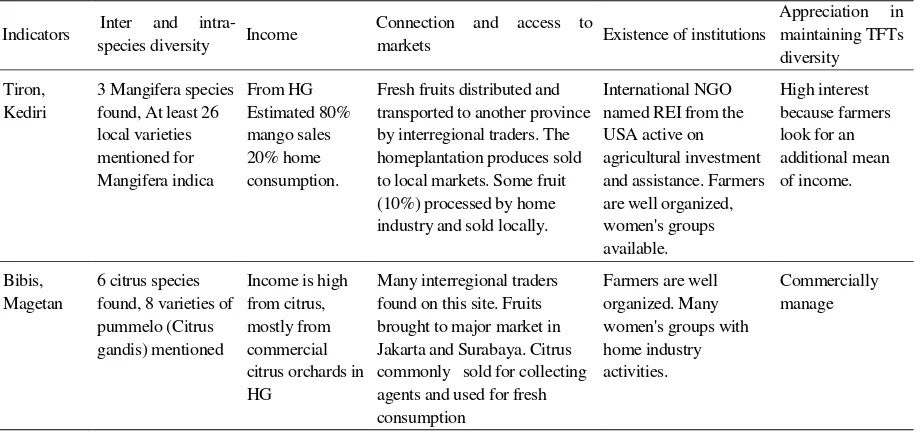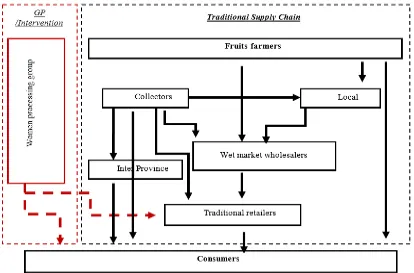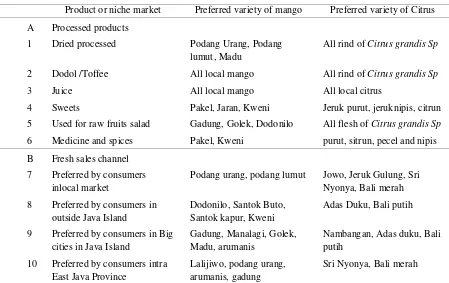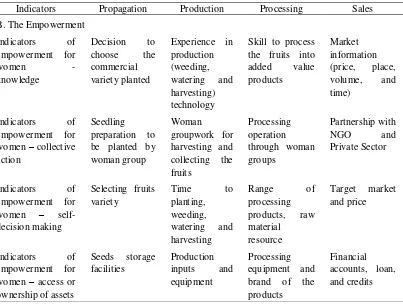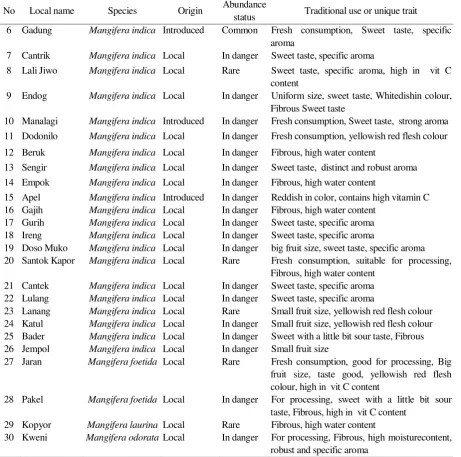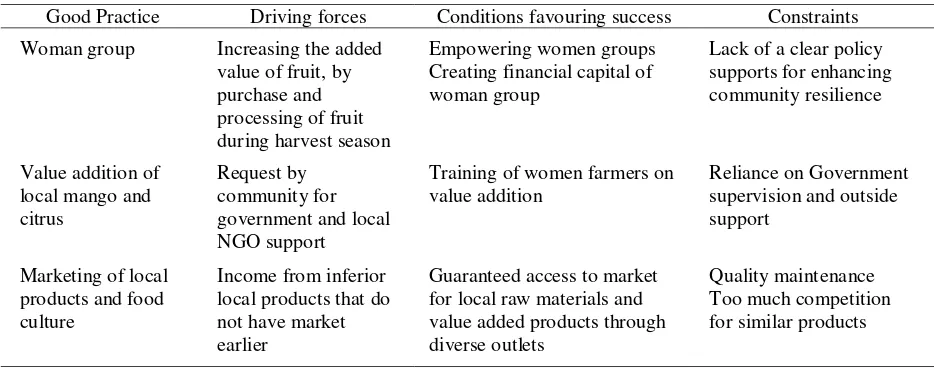GOOD PRACTICES FOR MAINTAINING DIVERSITY
OF TROPICAL FRUIT TREES THROUGH VALUE
ADDITION ACTIVITIES BY WOMAN FARMERS IN
EAST JAVA
Kuntoro Boga Andri
1*and Muhammad Prama Yufdy
21
Assessment Institute for Agricultural Technology West Sulawesi, IAARD-Ministry of Agriculture, Indonesia
2
Indonesian Center for Horticulture Research and Development (ICHORD), West Java, Indonesia
*corresponding author: [email protected]
ABSTRACT: The tropical fruits genetic resources, had a vital roles on nourish and source of income of local people as well as natural preservation. The study which was conducted at two sites in East Java Province, Indonesia during 2011 to 2012. The research goal is to describe the significane of empowering women group to improve processing and market local mangos and citrus products. The study have proved the income contribution from mango and citrus production and its derivatives in both sited may reach 51 and 55 percent of total family income. To overcome of cheap price of fruits in the harvest season and enhance processing activities, training on processing techniques of mango was carried out by Assessment Institute for Agricultural Technology (AIAT) in cooperation with NGO for the women farmers groups. In both sites, the processing units use all local varieties of fruits from the home garden and forest. Products currently are just sold in the local markets. Market expansion with an efficient distribution process in the future through promotion efforts may increase total consumers demand and marketing area. The practiced have maintaining diversity of tropical fruit trees through empowered women group to get the value added from local varieties of mango and citrus by process product and group marketing.
Keywords: conservation, fruit trees, women, value addition
INTRODUCTION
East Java in one of the Provinces in Indonesia which become the center of origin and diversity of numerous globally important tropical fruit tree species and their wild relatives (GEF 2008). This diversity is treasured for the livelihoods of local people throughout the country both as a source of nutrition and income as well as for urban consumers at the local, regional and even global levels for their nutritional properties (Maharjan et.al. 2011). On the other hand, most of the rural farming communities in East Java still lack the access to information regarding agricultural biodiversity, conservation, and communities in research and development activities (GEF 2008).
On-farm conservation is a management process by which farmers maintain the local crop varieties that they identified or developed within the local conditions and continued to manage and improve. On-farm conservation activities tend to
focus on persuading farmers to keep planting local varieties. This study primarily focuses on educating farmers about the value of local crop diversity, fostering the sense of pride in their cultural heritage of local diversity and promote its use at home or for sales (Sajise 2003; Sthapit et.al. 2008).
however does not necessarily mean that agro biodiversity is not mattered in agricultural markets. The significant share of tropical fruits produced is still sold in the domestic market rather than being exported. Local markets, which may provide more opportunity for agro biodiversity to be sold, however,are often associated with significant price volatility, a lack of value addition and the inadequate price premium for high quality. There is, thus, need to target relevant markets and products and enable smallholders to participate (Kruijssen and Somsri 2006; Bartlett 2008). The focus issue of this study is Good Practices (GP) on marketing and additional value activities of local mango and citrus species conducted by women farmers in Tiron community, Kediri sites, and Bibis community in Magetan Site, of East Java Provinces. Exploring local market opportunities and niches is often overlooked as an effective strategy for improving livelihoods and creating market value for local agricultural biodiversity.This paper exposes some examples how a market strategy for local markets can help farming communities to improve income, gender equality and conserve agricultural biodiversity.
Women play a significant role in the management and utilization of fruit tree diversity. However, their role is often not recognized. Women in Indonesia are traditionally involved in following activities related to fruit trees such as propagation, production, processing, and sales. However, often they have not participated in marketing yet,or their knowledge about traditional uses, processing techniques are being neglected while these can be of importance when exploring markets. Empowerment is defined as an emancipation process in which the disadvantaged are empowered to exercise their rights, obtain access to resources and participateactively in the process of shaping society and making decisions (Luttrell and Quiroz 2009). Indicators of empowerment are knowledge, collective action, self-decision making and access or ownership of assets (Kasmel and Andersen 2011).
RESEARCH METHODS
The focus areas of this GP are marketing and additional value activities of local mango and citrus species by women farmers in Tiron community, Kediri, and Bibis community in Magetan, of East Java Provinces. GIS reference of locations is 6048’47 S,1070 36’52 E (Kediri) 7039’50 S; 1110 11’43 E (Magetan). Name of farmers Group and citrus produces. The study aims to elaborate on Good Practices (GP) conducted by the communities on marketing and additional value activities of local mango and citrus species by women farmers in Tiron community, Kediri sites, and Bibis community in Magetan Site, of East Java Provinces. The data were obtained through conducting a baseline survey, in-depth interviews with key informants as well as FGDs (Focus Group Discussions) in both studied locations which are important production centers and genetic resources of mango and citrus in East Java. The descriptions of communities studied in both sites are illustrated in Table 1.
Within this study, market and non-market values of mango and citrus tree genetic resources will be assessed and proper practices for marketing and management of these resources will be characterized. On the approach to avoid the rapid loss of genetic diversity (genetic erosion) is through on-farm conservation activities.
The goal of this research is to improve livelihoods and food security of target beneficiaries through women empowerment to sustainand utilize Tropical Fruit Trees (TFTs) genetic resources. By strengthening the capacity of women’sfarmers’ and users’ groups will assure long-term implementation of practices that conserved and sustainably utilizedtropical fruit tree genetic resources. The study tries to develop a system that will promote well-balanced working between partners and stakeholders at the community level, develop an institutional framework, empower women farmer and establish mechanisms to generate support of
The Characteristics of Biodiversity and the Marketing Activities
people as well as its essential role in nature preservation.This study describes the significance of empowering women groups to improve
processing and local market of mangos and citrus products contributing to natural conservation.
Table 1. Description of Communities Studied
Site have a home garden and fruit production. sold to local market. Some fruit processed by home industry and sold locally. farmers look for an additional mean of have a home garden and fruit production. traders found on this site. Fruits brought to major market in Jakarta and Surabaya. Citrus commonly sold to collecting agents and used for fresh consumption farmers look for an additional mean of income.
Detail of sites characteristics and biodiversity setting in the studied areas are described in Table 2. Tiron site covering a lowland area of about 26.700 ha, with elevation 500 Meters Above Sea Level (MASL). Located in the center of East Java Province. With an average annual income from
TFTs of RP. 1,500,000, - (US$ 150, -) per farmers family. The mango fruits are usually sold directly bythe farmer to the middlemen orthe local market. From mango fruits it only may contribute 15-20 % of the family income.
Table 2 .Sites Characteristics and Biodiversity Setting in Studied Communities
Indicators Inter and
intra-species diversity Income
Connection and access to
markets Existence of institutions
Appreciation in
Fresh fruits distributed and transported to another province by interregional traders. The homeplantation produces sold to local markets. Some fruit (10%) processed by home industry and sold locally.
International NGO named REI from the USA active on found, 8 varieties of pummelo (Citrus found on this site. Fruits brought to major market in Jakarta and Surabaya. Citrus commonly sold for collecting agents and used for fresh consumption
Bibis site is the centre of the genetic resources of citrus in East Java, where the community has rich varieties of the citrus species as main crops in their home plantation. The site covers a lowland area of about 247.830 ha, with altitude 105 MASL, located in the mid-west of East Java province. The main income of the household averages aboutRP. 15,00,000 - (US$ 1500, -) from pummelo fruits. The total population of pummelo citrus trees is more than 50.000 trees, with an average yield of 100-200 kg/tree. The fruits are usually sold directly by each farmer to the middlemen or the local market by the farmers' group.
Figure. 1 describes the characteristicsof the existing supply chain system in the field. In this region, mangoes and citrus aregenerally consumed as a fresh fruit. Less than ten percent (10%) of the total production is processed into processed form. Fruits are mostly consumed to meet local market through the traditional supply chain. Most of mango and citrus produced in the field are marketed into the region of surrounding East Java provinces, and some of them aremarketedto the outside province.In both sites, the Good Practices and involvementby woman processing group through processing activities focus on the use of all local varieties of fruits from the home
plantations.Exploring and expanding new market channels with an efficient distribution process in the future through product variations and promotion efforts may increase consumers demand and marketing area (Figure 1).
The Description of Good Practices by Women Farmers in the Areas
Women farmers group processed only a few of variety of mango (variety/var. Podang urang/Mangifera indica) and citrus (var. adas nambangan/Citrus maxima) initially. Currently, the groups process for many variation of product such as dried mango (from var. podang urang, podang lumut, madu), Dodol/toffee mango (from var. gadung, golek, dodonili), mango juice (from var kweni), mango sweet ( from var. pakel, jaran), leather mango (from var. podang urang, podang lumut, madu) (see Table 3).Whereas product derived from citrus are: sweet pummelo rind (from all var. pummelo), Jelly (from var. jeruk gulung, pamelo magetan), Juice (from var. jeruk manis, keprok, sunkis), as well as local uses for medicine and spices (var. purut, sitrun, pecel and nipis) (see Table3).
Table 3. Identified products and niche markets for local diversity
Product or niche market Preferred variety of mango Preferred variety of Citrus
A Processed products
1 Dried processed Podang Urang, Podang lumut, Madu
All rind of Citrus grandis Sp
2 Dodol /Toffee All local mango All rind of Citrus grandis Sp
3 Juice All local mango All local citrus
4 Sweets Pakel, Jaran, Kweni Jeruk purut, jeruknipis, citrun
5 Used for raw fruits salad Gadung, Golek, Dodonilo All flesh of Citrus grandis Sp
6 Medicine and spices Pakel, Kweni purut, sitrun, pecel and nipis
B Fresh sales channel
7 Preferred by consumers inlocal market
Podang urang, podang lumut Jowo, Jeruk Gulung, Sri Nyonya, Bali merah
8 Preferred by consumers in outside Java Island
Dodonilo, Santok Buto, Santok kapur, Kweni
Adas Duku, Bali putih
9 Preferred by consumers in Big cities in Java Island
Gadung, Manalagi, Golek, Madu, arumanis
Nambangan, Adas duku, Bali putih
10 Preferred by consumers intra East Java Province
Lalijiwo, podang urang, arumanis, gadung
Sri Nyonya, Bali merah
Source: FGD, 2012
The system maintains and enhances inter and intra-crop diversity. This system creates a diverse option to farmers for using many local types of mango and citrus because the raw material of processed product produced by women farmer group come from many types of local mango and citrus species and varieties. Furthermore, farmers expand their option in planting a numerous fruits in
their home garden and forest. The practices maintain the diversity of tropical fruit trees through empowered women group to obtain the value added from local varieties of mango and citrus using activities in propagation, production, processing, and sales product through group marketing (see Table 4).
Table 4.The Involvement and Empowermentof Women farmers in TFTs Activities
Indicators Propagation Production Processing Sales
A. The Involvement Traditional role of women related to mango and citrus diversity
Collecting seed and maintain nursery
Weeding, watering, harvesting
peel, slice, washing, cooking, packing
Financial maintaining/ assistance Traditional role of men
related to mango and citrus diversity
Exchange planting material,
Collecting new scion and establish nursery
Plant protecting, fertilizing
Table 4.The Involvement and Empowermentof Women farmers (Continued)
Indicators Propagation Production Processing Sales
B. The Empowerment confirmed empowering women group can improve processing and marketing local mangos and citrus production. It is because each processing of products needs a particular species and varieties of fruits. For examples, product derived from mango are dried mango (from variety/var. of podang urang, podang lumut, madu), Dodol mango (from var. of gadung, golek, dodonili), mango juice (from
var. kweni), sweet mango (from var. pakel, jaran),
No Local name Species Origin Abundance
status Traditional use or unique trait
1 PodangUrang Mangifera indica Local Common Fresh consumption, suitable for processing, Uniform size, sweet taste, specific aroma, Reddish in colour, Fibrous
2 Podang Lumut Mangifera indica Local Common Fresh consumption, suitable for processing, sweet taste, specific aroma, Fibrous, yellowish red flesh colour
3 Madu Mangifera indica Introduced Rare Fresh consumption, Sweet taste, specific aroma
4 Golek Mangifera indica Introduced Common Fresh consumption, big fruit size, sweet taste, specific aroma
5 SantokButo Mangifera indica Local Rare big fruit size, sweet taste, specific aroma Source: Baseline survey, 2011
Table 5. Traditional use or unique trait of each var. Mango belongs to Kediri community
No Local name Species Origin Abundance
status Traditional use or unique trait
6 Gadung Mangifera indica Introduced Common Fresh consumption, Sweet taste, specific aroma
7 Cantrik Mangifera indica Local In danger Sweet taste, specific aroma
8 Lali Jiwo Mangifera indica Local Rare Sweet taste, specific aroma, high in vit C content
9 Endog Mangifera indica Local In danger Uniform size, sweet taste, Whitedishin colour, Fibrous Sweet taste
10 Manalagi Mangifera indica Introduced In danger Fresh consumption, Sweet taste, strong aroma 11 Dodonilo Mangifera indica Local In danger Fresh consumption, yellowish red flesh colour
12 Beruk Mangifera indica Local In danger Fibrous, high water content
13 Sengir Mangifera indica Local In danger Sweet taste, distinct and robust aroma 14 Empok Mangifera indica Local In danger Fibrous, high water content
15 Apel Mangifera indica Introduced In danger Reddish in color, contains high vitamin C 16 Gajih Mangifera indica Local In danger Fibrous, high water content
17 Gurih Mangifera indica Local In danger Sweet taste, specific aroma 18 Ireng Mangifera indica Local In danger Sweet taste, specific aroma
19 Doso Muko Mangifera indica Local In danger big fruit size, sweet taste, specific aroma 20 Santok Kapor Mangifera indica Local Rare Fresh consumption, suitable for processing,
Fibrous, high water content 21 Cantek Mangifera indica Local In danger Sweet taste, specific aroma 22 Lulang Mangifera indica Local In danger Sweet taste, specific aroma
23 Lanang Mangifera indica Local Rare Small fruit size, yellowish red flesh colour 24 Katul Mangifera indica Local In danger Small fruit size, yellowish red flesh colour 25 Bader Mangifera indica Local In danger Sweet with a little bit sour taste, Fibrous 26 Jempol Mangifera indica Local In danger Small fruit size
27 Jaran Mangifera foetida Local Rare Fresh consumption, good for processing, Big fruit size, taste good, yellowish red flesh colour, high in vit C content
28 Pakel Mangifera foetida Local In danger For processing, sweet with a little bit sour taste, Fibrous, high in vit C content
29 Kopyor Mangifera laurina Local Rare Fibrous, high water content
30 Kweni Mangifera odorata Local In danger For processing, Fibrous, high moisturecontent, robust and specific aroma
Table 6. Traditional use or unique trait of var. citrus belongs to Magetan community
Source: Baseline survey, 2011
The practice maintains thediversity of TFT through empowered women group to get the added value from varieties of local mango and citrus using processed product and group marketing. In the beginning, the farmers have already had their own processing technique. Moreover, in both project sites then they got training from, the government research Institution (AIAT), Brawijaya
University, and NGOs (REI and Pummelo Association) provide them training to improve the processing technology. Further, the system has been practiced by 90 farmers in Kediri and 30 farmers in Magetan. It spreads out to the other villages and following this system (see Figure 2 and Figure 3).
Figure 2. Mango processing activities and its products by Tiron’s woman farmer group in Kediri
Picture credit: Kuntoro Boga Andri (Foto taken at 2011)
No. Local name Species Origin Abundance
status Traditional use or unique trait
1 Adas Citrus grandis Local Common Fresh consumption, long selflife, bitter sweettaste
2 Adas Duku Citrus grandis Local Common Fresh consumption, long selflife
3 PameloMagetan Citrus grandis Local Commercial Fresh consumption, high in vit C content
4 Sri Nyonya Citrus grandis Local Commercial Taste good, redish red flesh color, High vit C content
5 Bali Merah Citrus grandis Local Commercial Taste good, redish red flesh color, High vit C content
6 Bali Putih Citrus grandis Local Commercial Fresh consumption, long selflife, bitter sweet taste
7 Jeruk Gulung Citrus grandis Local Endanger Big size, long selflife, Fresh consumption, sweet taste
8 Jeruk Jowo Citrus grandis Local Endanger Big size, long selflife, Fresh consumption, sweet taste
9 Nambangan Citrus grandis Local Common Fresh consumption, long selflife, sweet bitter taste
10 Keprok Siem Citrus reticulata Introduced Endanger Fibrous, high water content, high in vit C content
11 Keprok Pulung Citrus reticulata Introduced Endanger Coarse, high water content
12 Keprok Manis Citrus sinensis Introduced Rare Coarse, high water content
13 Sunkiest Citrus sinensis Introduced Rare High vitamin C
14 Jeruk Purut Citrus histryx Introduced Rare Small in size, High vitamin C
15 Jeruk pecel/ nipis Citrus aurantiifolia Introduced Rare Small in size, High vitamin C
Figure - 3. Sweet pummelo rind produced by women farmer group in Bibis, Magetan Picture credit: Kuntoro Boga Andri (Foto taken at 2011)
Impact of the System on Livelihoods and Social Well-being
Fruit trees belonged are paramount for food security and source of income for farmers’ through marketing and processing activities. This system susssfully proves that empowering women's group can improve processing and marketing local mangos and citrus production.
The average incomes from TFT for the Household in the studied area are significantly necessary. From mango fruits only in Kediri, it may contribute 12% on average to the family income.
While in Magetan, it can achieve 32% of the total income. The income contribution may increase from 12%, become 51% for mango, and from 32% to 55% for citrus when the farmers processed the mango and citrus and sell it product self. Since the system provides women jobs and generate additional income for households, it will stand for longer periods (see Table 7). Since the system provides women jobs and generates additional revenue for households, it will stand for more extended periods.
Table 7. Average income contribution for households from fruit tress without and with processing activities (%)
Community
Income Contribution Without TFTs
Processing Income Contribution With TFTs Processing
From Fruits
Other Agriculture
Activities
Non-Agriculture From Fruits
Other Agriculture
Activities
Non-Agriculture
Tiron, Kediri 12 28 60 51 16 33
Bibis, Magetan 32 16 52 55 11 34
Source: Baseline survey, 2011
This system also shows the enhancement of livelihood assets throughtheempowering human capital, mainly using women group empowerment, innovation training, packaging improvement targeted to thecostumer, and production and market training for product export. These good practices enhancee social capital by arousing awareness on collective actions, strengthening skills of women groups in collective actions and local institutional building and equitable sharing of profits and risk amongst member of shareholders. Also, it is enhancing natural capital by exercising diversity assessment of home gardens that have the potential to market.
This system use many types of local mango and citrus from home gardens or semi-commercial
creates a link with the external network regarding marketing.
This system demonstrates livelihoods strategies by employing collective action and organization to do the processing of mango for additional income, processing and marketing of numerous local mango and citrus products, and improve the quality of product and increase the sale. Also, we need to concern on conducting regular woman group meeting, organizing need-based skill to enhances training, strengthening the capacity of woman group, and maintaining transparency of running woman group as well as creating a proper management of local mango and citrus in the orchards and home garden and expansion of mango trees cultivation into forest area.
This system provides credit facilities to individual women farmers and provides labour for wages. As well as woman group uses micro credit provider from local government to establish processed fruit facilities, setting up the market outlets of woman group in the community. This system, regarding the livelihood outcome, provides the greater opportunity for revenue by employing women in group work as well as shares revenue and creating a link with other network of value chain actors.
This system provides the provision of sustainable benefits to farmers as well. Ministry of
Agriculture awarded the grant to PUAP scheme (Rural Agribusiness Enterprises Development) program for financial support and mango products recognized for export quality by local NGO as well as the physical infrastructure of the woman group established as results of collective action. This GP has impacts on awareness of processing technology enhancement, the partnership development, women empowerment, income supplementation, diversity mango and citrus maintenance, stakeholder benefits, increasing income, the improvement of diversity value, raising awareness of community, collaborations development and community empowerment.
Development Opportunities and Challenges
This GP ofempoweredwomenhas proven to increase the added value of fruit, by purchasing and processing of fruit during harvest season when the prices of fruits down and providing wages for working in grain processing work. The conditions favouring success by empowering women groups create the financial capital of woman group by the purchasing of shares by the members. The constraints of the success area lack of an explicit policy support to elevate the absence of research among community and the insufficience development of new type of product (see Table 8).
Table 8. Driving forces and conditions favouring or hindering successful the System
Good Practice Driving forces Conditions favouring success Constraints
Woman group Increasing the added value of fruit, by purchase and processing of fruit during harvest season
Empowering women groups Creating financial capital of woman group
Lack of a clear policy supports for enhancing government and local NGO support
Training of women farmers on value addition
Reliance on Government supervision and outside support
Marketing of local products and food culture
Income from inferior local products that do not have market earlier
Guaranteed access to market for local raw materials and value added products through diverse outlets establishing processed fruits home industry in the community. The condition favouring the success of
The constraints of the success of this GP are reliance on government supervision and external support, and preference to few market demanded fruit cultivars that do not support diversity enhancement.
The GP is important to increase the income of low-grade products, which initially has no potential market. The condition favouring the success of this GP are guaranteed access to the market for local raw materials and value added products through diverse outlets (woman group stores, warung/grocery stores inside and a neighboring village, exports possibilities through NGO Support).
The constraints of the success of this GP are quality maintenance and much competition for similar products. The actions that has to be taken are:
a. Community meeting to hold a dialog on the importance of maintaining local varieties of mango, market value of fresh and processed products of local varieties
b. Developing a marketing system of fruit products through farmer group or association. c. Training on farmers to farmers to improve
processing technology of mango and citrus. AIAT, University, and Agri-Extension Service supervise this trainning.
CONCLUSION
Fruit trees that belong to the communities are paramount for food security and source of income for households through marketing and processing activities. This system has confirmed by empowering women's group to improve processing and local market mangos and citrus products. The average incomes from TFT for the Household in the studied area are significantly necessary. The revenue contribution increased from 12%, become 51% for mango, and from 32% to 55% for citrus. The contribution of income can be increased when the farmers process the mango and citrus, then sell it by themselves. To overcome of cheap price of fruits in the harvest season and enhance processing activities, training on processing techniques of mango carried out by AIAT in cooperation with NGO for the women’s groups.
The products are being sold in the local markets. Therefore, by having a market expansion with an efficient distribution process in the future through promotion efforts can increase the total consumers demand and marketing area. The which funded this regional research project. This on-farm conservation study is incorporated into Indonesian Center of Horticulture Research (ICHORD) of Indonesian Agency for Research and Development (IAARD) and the Bioversity International, by focused on mango and citrus.
REFERENCES
Bartlett, Andrew. (2008). No more adoption rates! Looking for empowerment in agricultural development programmes. Development in Practice,18:4,524 — 538.
Global Environment Facility (GEF). (2008). Proposal Project Document Entitled -
Conservation and Sustainable Use of
Cultivated and Wild Tropical Fruit Diversity: Promoting Sustainable Livelihood, Food Security and Ecosystem Services.
Kasmel, Anu and Andersen, Pernille Tanggaard.
(2011). Measurement of Community
Empowerment in Three Community
Programs in Rapla (Estonia). Int. J. Environ. Res. Public Health 2011, 8, 799-817;
Kruijssen, Froukje and Somsri S. (2006). Marketing Local Biodiversity in Thailand: Identification of a Possible Good Practice for on farm Biodiversity Management of Tropical Fruit Trees. Paper of Confer on International Agricultural Research for Development. University of Bonn.
Luttrell, Cecilia and Quiroz, Sitna. (2009).
Understanding and operationalising
empowerment, ODI (Overeas Development
institute) Working Papers 308, 111
Westminster Bridge Road London/
Maharjan, Shree Kumar, Assa Ram Gurung, and B.R. Sthapit. (2011). Enhancing On-Farm Conservation of Agrobioversity Through Community Seed Bank: An Experience of Western Nepal. The Journal of Agriculture and Environment Vol:12, Jun.2011.
Sajise, Percy E. (2003). Agrobiodiversity and Sustainable Development: What, Why and for
Whom, in Landscapes of Diversity:
Indigenous Knowledge, Sustainable
Livelihoods and Resource Governance in
Montane Mainland Southeast Asia.
China. Xu Jianchu and Stephen Mikesell, eds. pp. 289–294. Kunming: Yunnan Science and Technology Press.
